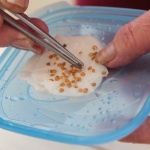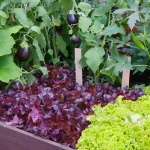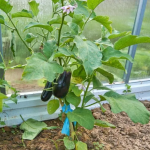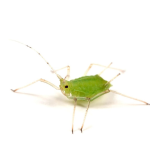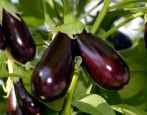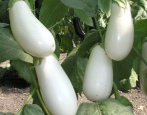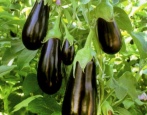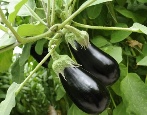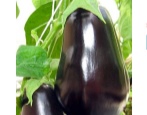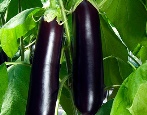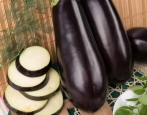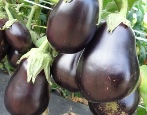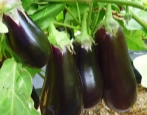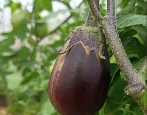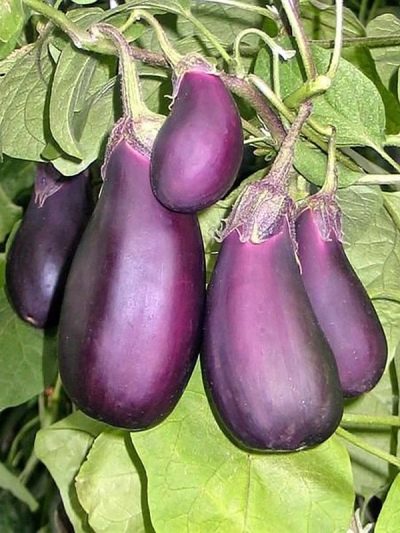
- Authors: Borisov A.V., Boriskina E.B.
- Year of approval: 2000
- Growth type: medium-sized
- Bush height, cm: 70-100
- Fruit shape: pear-shaped
- Fruit weight, g: 200-300
- Yield: high yielding
- Fruit color: lilac
- Ripening terms: very early
- Pulp (consistency): dense
Robin Hood eggplant is not the most common variety, but it also attracts gardeners. It is worth considering in more detail the features of the plant, as well as the characteristics of the fruits and the planting scheme.
Description of the variety
Breeders from Russia were engaged in breeding the Robin Hood variety. The eggplant successfully passed all the tests and was entered in the state register. Today the Robin Hood variety is in demand in many regions of the country due to its yield and unpretentious care.
Characteristics of the appearance of plants and fruits
Robin Hood presents - a variety from a group of plants with the earliest ripening period. Key characteristics include:
- small bushes, height - 70-100 cm;
- fairly strong stems;
- medium-sized leaves, green, with smooth edges.
The crop can be grown in a greenhouse and open field. During the growing period, the variety forms only a couple of lateral shoots, on which fruits are subsequently formed. The leaf plates in the lower part give off a slightly whitish tint.
Compact bushes of Robin Hood do not require much space on the site. Features of eggplant:
- shape - predominantly pear-shaped;
- length - up to 20 cm;
- diameter - 8-9 cm;
- weight - from 200 to 300 g.
The skin has a rich lilac hue and high density. The vegetable is well transported, which is one of the main advantages of the culture. The color of the fruit pulp is predominantly white.
Purpose and taste
Robin Hood is characterized by delicious fruits that have no bitterness on the palate. Eggplants are fried, baked, used for caviar.
Ripening terms
With the right approach to cultivation, it will be possible to get the first eggplants after 100 days. If the variety is planted in a greenhouse, the ripening time will be reduced to 90 days.
Yield
The average figure reaches 12 kg per square meter. If agrotechnical recommendations are not followed, the yield drops to 7 kg.
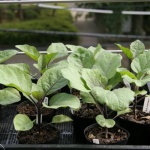
To get a tasty and bountiful eggplant crop, you must first grow strong and healthy seedlings. This culture is considered very capricious, therefore, you need to take care of seedlings when growing at home as correctly and carefully as possible.
Growing and care
Robin Hood is a seedling-resistant variety that is resistant to the vagaries of the weather. The planting of culture in the southern regions is carried out towards the end of May, in more northern regions - by the beginning of June. If you plan to grow eggplant in a greenhouse, then you can start work already in the first days of the last month of spring.
For planting seedlings, special cups are used, inside which there is a fertile mixture. The maximum depth of planting seeds should not exceed 2 cm. After planting pre-treated and selected seeds, the container is watered and covered with gauze or transparent glass. Further, future seedlings are placed in a sunny place and wait for the first shoots, not forgetting to air and water the soil.
Transplanting ready-made seedlings into open ground or a greenhouse is performed by the end of spring or early June. The minus of the Robin Hood variety is in its weak root system, so the procedure should be approached carefully.
At first, it is recommended to hide young bushes from the sun's rays so that the plant does not die. After 1-2 weeks, you can start caring for the plant. The main recommendations are as follows.
- Eggplant is undemanding to watering, so it is often not worth adding water to the soil. It is recommended to rely on soil moisture levels as well as climatic conditions. For example, in a drought, it is better to increase the volume of water.
- Robin Hood prefers nitrogenous or potash fertilizers as top dressing. The plant practically does not need phosphorus. It is also worth considering the use of organic fertilizers during the period of active growth.
- To improve the formation of bushes, the plant should be periodically sprayed with the preparations "Ovary" or "Bud".
You also need to devote time to shaping the bush, through which it will be possible to increase yields. It is also recommended to remove the affected or too long elements. When growing eggplants in a greenhouse, they need to be ventilated.

Planting eggplant is one of the most important stages in growing. When choosing a place for eggplants on your site, it is important to remember that this culture should be in warm soil, constantly illuminated by the sun. The plant is also very fond of spacious, open spaces, since its roots can grow over sufficient areas.
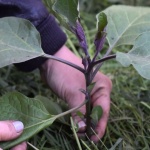

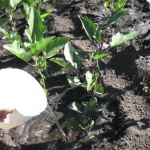
Soil requirements
Before replanting seedlings, you need to find the best place. Basic conditions:
- the substrate must be fertile and have a neutral pH;
- before planting, the land is fertilized and fluffed;
- heavy soils are diluted with sand.
Disease and pest resistance
Robin Hood is not able to boast of strong immunity. Among the common "guests" are:
- spider mite;
- aphids;
- Colorado potato beetle.
To improve the health of the bushes, they need to be processed. Summer residents are advised to use agents with a complex composition for prevention purposes. Fitoverm, Iskra-BIO and Zdorovy Sad should be used as such preparations.

Eggplant is one of the most demanding crops. For its successful cultivation, it is necessary to create optimal conditions, as well as to carry out prevention and fight against diseases and pests. Eggplant often infects both fungal and viral diseases. If treatment is not started on time, you can completely lose the crop.
Review overview
Gardeners respond positively to Robin Hood eggplant. The main advantages of the popular variety include:
- large fruits;
- ease of care;
- excellent survival rate.
Also, reviews report on the suitability of eggplant fruits for transportation.
